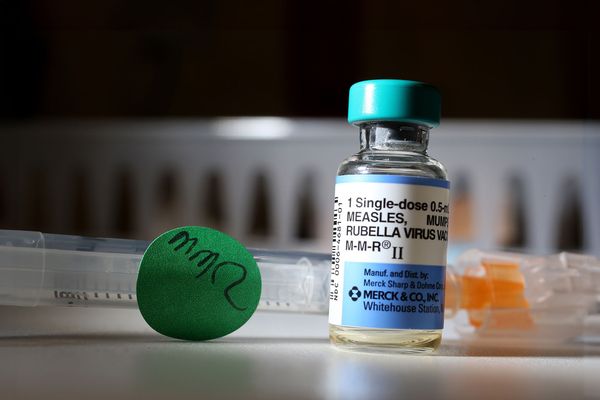LOS ANGELES — Coronavirus cases are continuing to climb in California, but it remains unclear whether hospitalizations will also begin to tick upward, as is already happening nationally.
California is now reporting an average of about 5,000 new coronavirus infections a day, up nearly 85% from last month.
Statewide, the coronavirus case rate has risen to 95 cases a week for every 100,000 residents. A rate of 100 or more is considered a high rate of transmission — the worst of four categories defined by the U.S. Centers for Disease Control and Prevention.
But hospitalizations have yet to follow the same path in California, and in fact are at near-record lows. On Monday, 950 coronavirus-positive patients were hospitalized statewide.
Los Angeles County is experiencing a similar trend. The nation’s most populous county is now reporting nearly 1,700 cases a day — which amounts to a rate of 115 cases a week for every 100,000 residents. The last time the county’s case rate exceeded 100 was early March.
Like the state, this bump in cases has not yet triggered a flood of new COVID-19 patients. On Friday, the number of coronavirus-positive patients in Los Angeles County fell to 209 — the lowest single-day total on record, state data show. The count had crept up slightly, to 232, as of Monday.
The fact that hospitalizations haven’t yet risen in L.A. County “may be due to the typical delay we see between cases and hospitalizations,” Public Health Director Barbara Ferrer said last week.
But it’s also possible “that fewer infected individuals are requiring hospital care at this time, which suggests that vaccines and therapeutics are doing a great job preventing severe disease,” she added.
The San Francisco Bay Area is still experiencing a low hospitalization rate, despite the region having California’s highest case rate — at 143 cases a week for every 100,000 residents.
Dr. Peter Chin-Hong, infectious-diseases expert at UC San Francisco, tweeted Friday that “hospitals (were) eerily quiet.” Only 12 coronavirus-positive patients were at the campus’ hospitals that day, and none needed to be hooked up to machines to help them breathe.
“Cautious hope,” he wrote.
It’s also possible California is simply running behind other parts of the nation, a trend previously observed in the pandemic.
Some experts say the national increase in cases — fueled by the BA.2.12.1 Omicron subvariant that is now dominating New York — appears to be steadily increasing.
The new “wave is gaining steam,” tweeted Dr. Eric Topol, director of the Scripps Research Translational Institute in La Jolla.
Nationally, 47,000 coronavirus cases a day are being reported, more than 80% higher than a month ago. There are nearly 1,800 new coronavirus-positive hospitalizations in the U.S. daily — up 16% from the previous week, but still among the lowest figures of the pandemic.
Fatalities are also continuing to fall or remain stable, although an average of about 300 COVID-19 deaths are still being reported nationwide each day. California is averaging about 50 COVID-19 deaths a day, and L.A. County, about 10 per day.
“Still too many, still too high, but doing so much better than we have throughout much of this pandemic,” Dr. Ashish Jha, the White House COVID-19 coordinator, said Tuesday at a briefing. In 2021, COVID-19 was the third leading cause of death nationally, with an estimated 415,000 deaths — more than twice the number of deaths blamed on strokes.
Jha characterized the recent increase in hospitalizations as not a “huge bump,” and said his key indicators going forward will be whether hospitals begin to get stressed and if death rates increase.
He urged Congress to act on the White House’s requests for billions in additional funding to fight the pandemic, including funding a next generation of vaccines that could be available this fall or winter that could be more effective and longer lasting.
“None of those are going to be available to the American people if we don’t get more funding,” Jha said. He also urged greater funding to get “shots in arms around the world.”
Jha also announced the increasing availability of the anti-COVID-19 pill Paxlovid, which authorities say reduces the risk of hospitalization by 90%.
The federal government is now offering Paxlovid directly, Jha added, and the number of sites nationwide that carry the pills will go from 20,000 to 40,000 in the next couple of weeks.
As supplies of Paxlovid are becoming increasingly plentiful, he urged doctors to prescribe the drug to anyone who qualifies for it: namely, patients “at high risk of progressing to severe COVID-19.” But the pills work best when given early, and can no longer be administered six days after the onset of symptoms.
One reason why the nation may be well armored against another COVID-19 wave this spring, even with the proliferation of omicron and its super-infectious family of subvariants, is that so many people have some degree of protection against the latest strain of the coronavirus — either because they’ve been vaccinated or have recently been infected.
A report published by the CDC on Tuesday estimated that, as of February, nearly 60% of U.S. residents have survived a coronavirus infection. That’s up from an estimate of about 34% in December, before omicron began to stampede across the country.
The report estimated that as of February, 75% of children and adolescents have survived a coronavirus infection, up from about 45% in December.
“These findings illustrate a high infection rate for the omicron variant, especially among children,” the report said.
Scientists caution that immunity from surviving an infection wanes over time, and “vaccination remains the safest strategy for preventing complications” from a coronavirus infection, including hospitalization and death. Natural immunity can also fade considerably when faced with a new variant.
Some scientists have also said they wouldn’t be surprised if there’s an increase in cases in the late summer or early fall — around when school resumes — and in the late fall and early winter.







